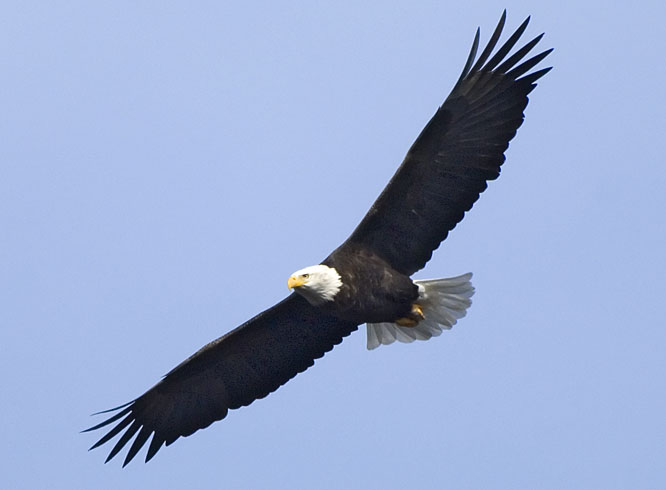Fast Facts about the River
It’s a bird! It’s a plane! No, you were right the first time, it’s a bird. A bald eagle to be exact! If you’ve spent a good chunk of time out on the St. Croix River you’ve probably seen one of these magnificent birds. 50 years ago you wouldn’t have seen one mainly due to DDT poisoning and hunting. They remained an endangered, and then threatened, species for 32 years. Today this top predator is back to healthy numbers. On a boat ride down the St. Croix it’s possible to see their massive nests high in the trees as well as the bird itself. For more bald eagle information check this out!
Ways to Protect the River
Protect our wildlife by protecting the land and water they live in. Always take your trash with you, follow boating no-wake rules and give wildlife appropriate space.
The St. Croix River Association is dedicated to preventing the spread of aquatic invasive species as we protect, restore and celebrate the St. Croix River and its watershed.
Learn more about our programs and ways you can get involved by visiting our website at stcroixriverassociation.org.
Fact Sheet: Natural History, Ecology, and History of Recovery
Via the National Fish & Wildlife Service
A North American species with a historic range from Alaska and Canada to northern Mexico, the bald eagle is an Endangered Species Act success story.

Forty years ago, our national symbol was in danger of extinction throughout most of its range. Habitat destruction and degradation, illegal shooting, and the contamination of its food source, largely as a consequence of DDT, decimated the eagle population. Habitat protection afforded by the Endangered Species Act, the federal government’s banning of DDT, and conservation actions taken by the American public have helped bald eagles make a remarkable recovery.
Bald Eagle Biology
Distinguished by a white head and white tail feathers, bald eagles are powerful, brown birds that may weigh 14 pounds and have a wingspan of 8 feet. Male eagles are smaller, weighing as much as 10 pounds and have a wingspan of 6 feet. Sometimes confused with golden eagles, bald eagles are mostly dark brown until they are four to five years old and acquire their characteristic coloring. There is a distinction between the two species, though, even during the early years. Only the tops of the bald eagle’s legs have feathers. The legs of golden eagles are feathered all the way down.
Bald eagles live near rivers, lakes, and marshes where they can find fish, their staple food. Bald eagles will also feed on waterfowl, turtles, rabbits, snakes, and other small animals and carrion.
Bald eagles require a good food base, perching areas, and nesting sites. Their habitat includes estuaries, large lakes, reservoirs, rivers, and some seacoasts. In winter, the birds congregate near open water in tall trees for spotting prey and night roosts for sheltering.
Eagles mate for life, choosing the tops of large trees to build nests, which they typically use and enlarge each year. Nests may reach 10 feet across and weigh a half ton. They may also have one or more alternate nests within their breeding territory. In treeless regions, they may also nest in cliffs or on the ground. The birds travel great distances but usually return to breeding grounds within 100 miles of the place where they were raised. Bald eagles may live 15 to 25 years in the wild, longer in captivity.
Breeding bald eagles typically lay one to three eggs once a year, and they hatch after about 35 days. The young eagles are flying within three months and are on their own about a month later. However, disease, lack of food, bad weather, or human interference can kill many eaglets. Recent studies show that approximately 70 percent survive their first year of life.
The Plight of the Bald Eagle
When America adopted the bald eagle as the national symbol in 1782, the country may have had as many as 100,000 nesting eagles. The first major decline of the species probably began in the mid to late 1800’s, coinciding with the decline of waterfowl, shorebirds, and other prey.
Although they primarily eat fish and carrion, bald eagles used to be considered marauders that preyed on chickens, lambs, and domestic livestock. Consequently, the large raptors were shot in an effort to eliminate a perceived threat. Coupled with the loss of nesting habitat, bald eagle populations declined.
In 1940, noting that the species was “threatened with extinction,” Congress passed the Bald Eagle Protection Act, which prohibited killing, selling, or possessing the species. A 1962 amendment added the golden eagle, and the law became the Bald and Golden Eagle Protection Act.
Shortly after World War II, DDT was hailed as a new pesticide to control mosquitoes and other insects. However, DDT and its residues washed into nearby waterways, where aquatic plants and fish absorbed it. Bald eagles, in turn, were poisoned with DDT when they ate the contaminated fish. The chemical interfered with the ability of the birds to produce strong eggshells. As a result, their eggs had shells so thin that they often broke during incubation or otherwise failed to hatch. DDT also affected other species such as peregrine falcons and brown pelicans.
In addition to the adverse effects of DDT, some bald eagles have died from lead poisoning after feeding on waterfowl containing lead shot, either as a result of hunting or from inadvertent ingestion.
By 1963, with only 487 nesting pairs of bald eagles remaining, the species was in danger of extinction. Loss of habitat, shooting, and DDT poisoning contributed to the near demise of our national symbol.
 The Road Back
The Road Back
As the dangers of DDT became known, in large part due to the 1962 publication of Rachel Carson’s book Silent Spring, the Environmental Protection Agency took the historic and, at the time, controversial step of banning the use of DDT in the United States. That was in 1972, and it was the first step on the road to recovery for the bald eagle.
In 1967, the Secretary of Interior listed bald eagles south of the 40th parallel under the Endangered Species Preservation Act of 1966. Following enactment of the Endangered Species Act of 1973, the Service listed the species in 1978 as endangered throughout the lower 48 states, except in Michigan, Minnesota, Oregon, Washington, and Wisconsin where it was designated as threatened.
“Endangered” means a species is considered in danger of extinction throughout all or a significant portion of its range. “Threatened” means a species is considered likely to become endangered within the foreseeable future but is not currently in danger of extinction.
The species was not listed as threatened or endangered in Hawaii because it does not occur there, or in Alaska, because populations there have remained robust.
Listing the species as endangered provided the springboard for the Service and its partners to accelerate the pace of recovery through captive breeding programs, reintroduction efforts, law enforcement, and nest site protection during the breeding season.
In July 1995, the Service announced that bald eagles in the lower 48 states had recovered to the point where those populations previously considered endangered were now considered threatened.
In July 1999, the Service proposed to remove the bald eagle from the list of threatened and endangered species. Since then, the Service has reviewed comments received on that proposal along with new data and information to determine the best ways to manage the species once it is removed from the protections of the Endangered Species Act. In 2006, the Service re-opened the public comment period due to new information on the proposal to delist. Data gathered during this comment period was factored into a final decision on the status of the species.
Based on the most recent population figures, the Service estimates that there are at least 9,789 nesting pairs of bald eagles in the contiguous United States. Bald eagles have staged a remarkable population rebound and have recovered to the point that they no longer need the protection of the Endangered Species Act.
Thus, on June 28, 2007, the Service announced the recovery of our nation’s symbol and removal from the list of threatened and endangered species.
What Lies Ahead
Although the Service removed the bald eagle from the list of threatened and endangered species under the Endangered Species Act, the bird will still be protected by the Migratory Bird Treaty Act and the Bald and Golden Eagle Protection Act. Both laws prohibit killing, selling or otherwise harming eagles, their nests, or eggs.
The Service will continue to work with state wildlife agencies to monitor the status of bald eagles for a minimum of five years, as required by the Endangered Species Act. If the species should need the protection of the Act, the Service can relist it as endangered or threatened. In the meantime, individual states may also pass or implement laws to protect bald eagles.
Fact Sheet Revised June 2007


